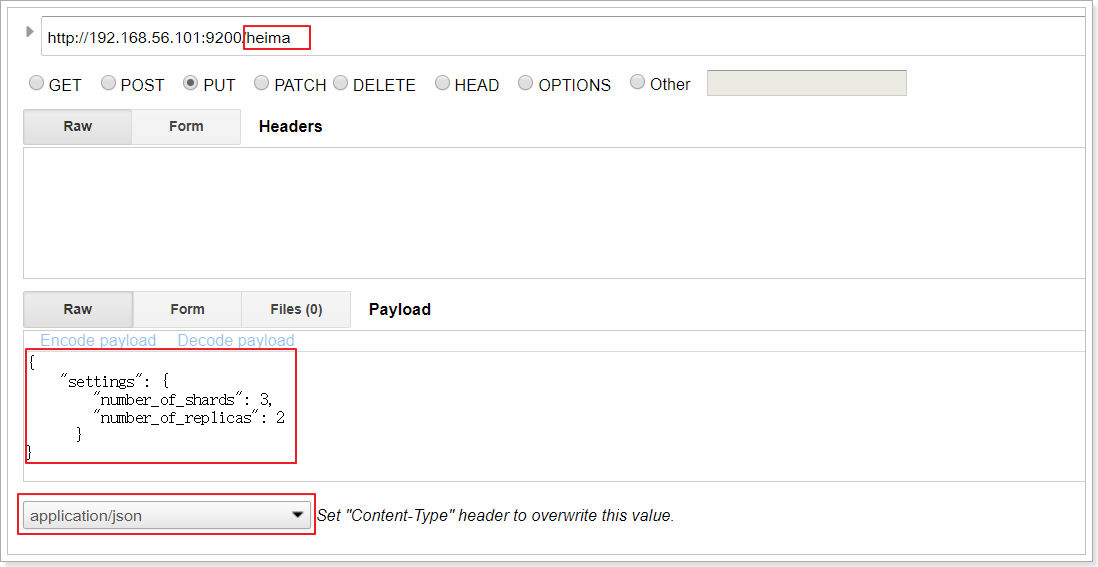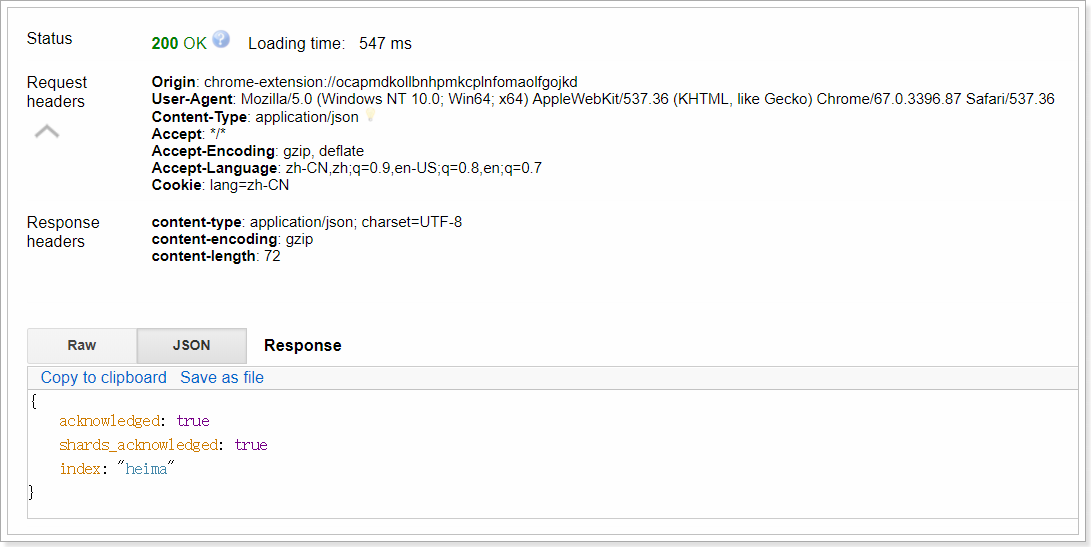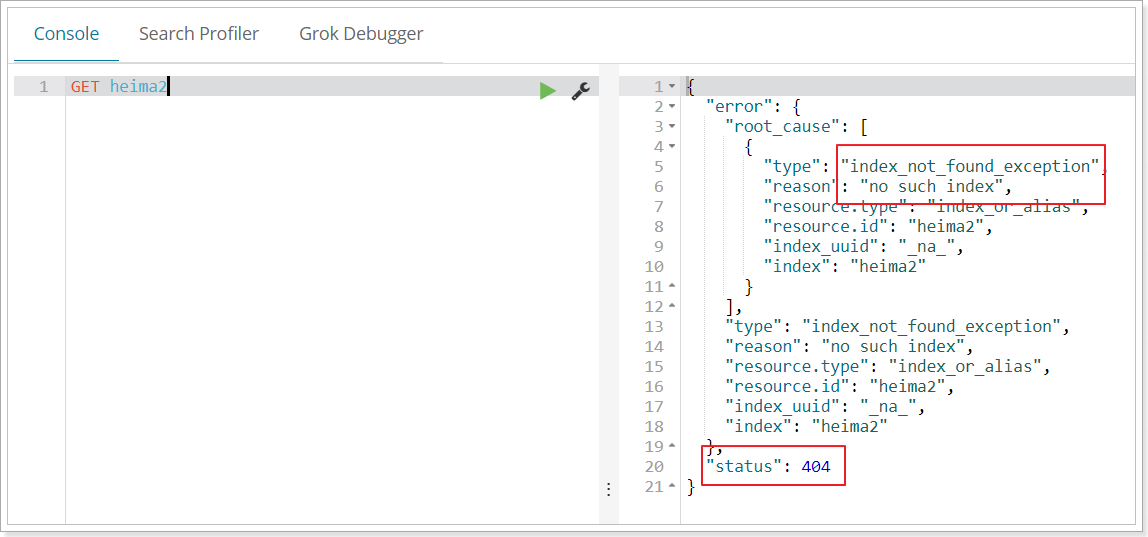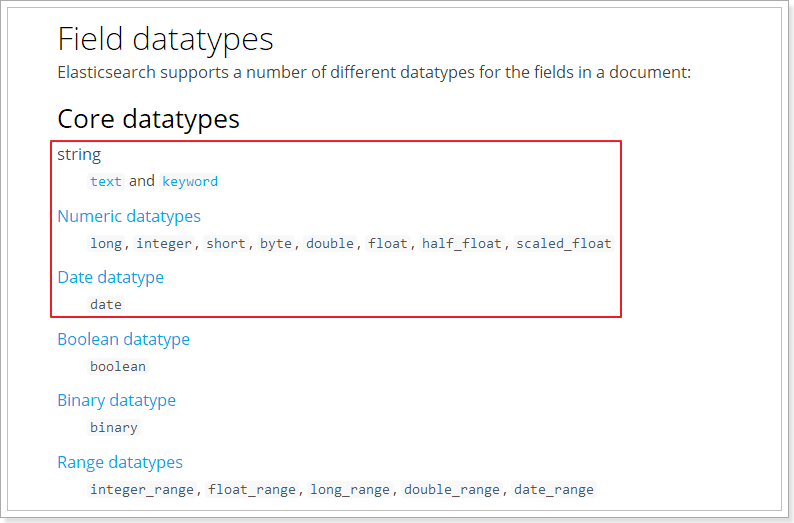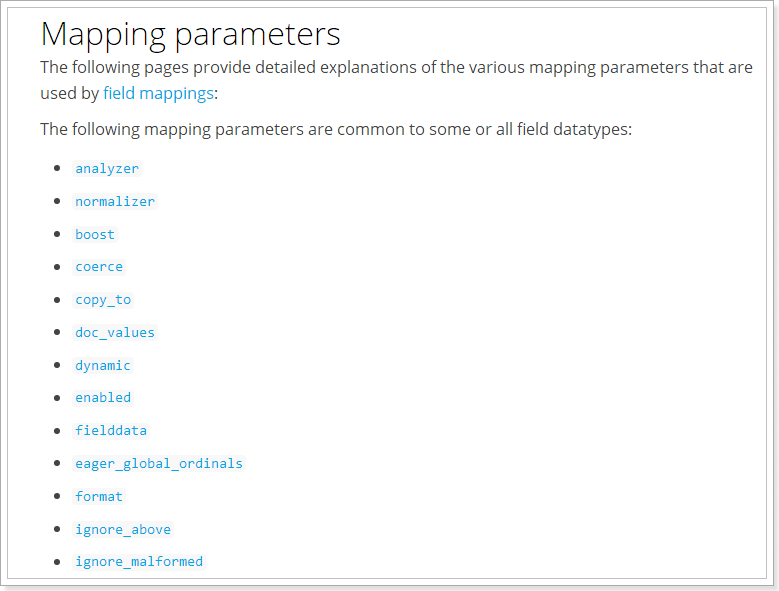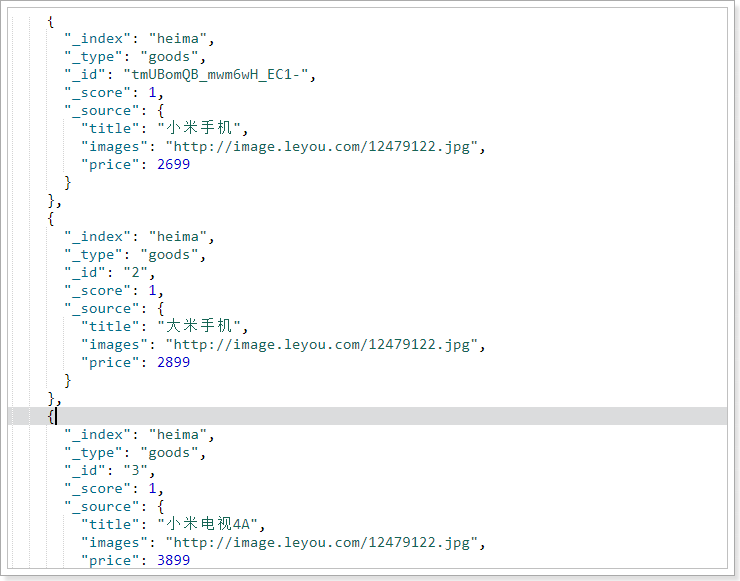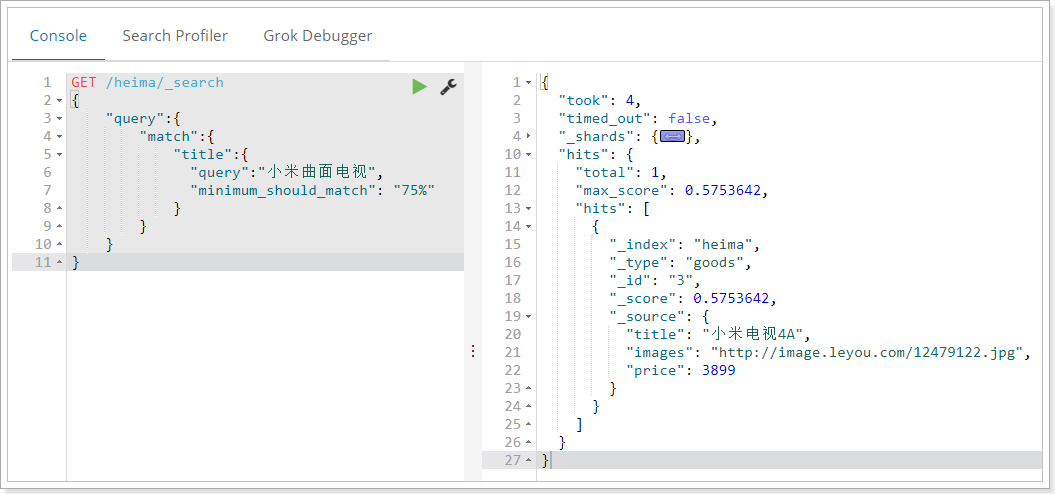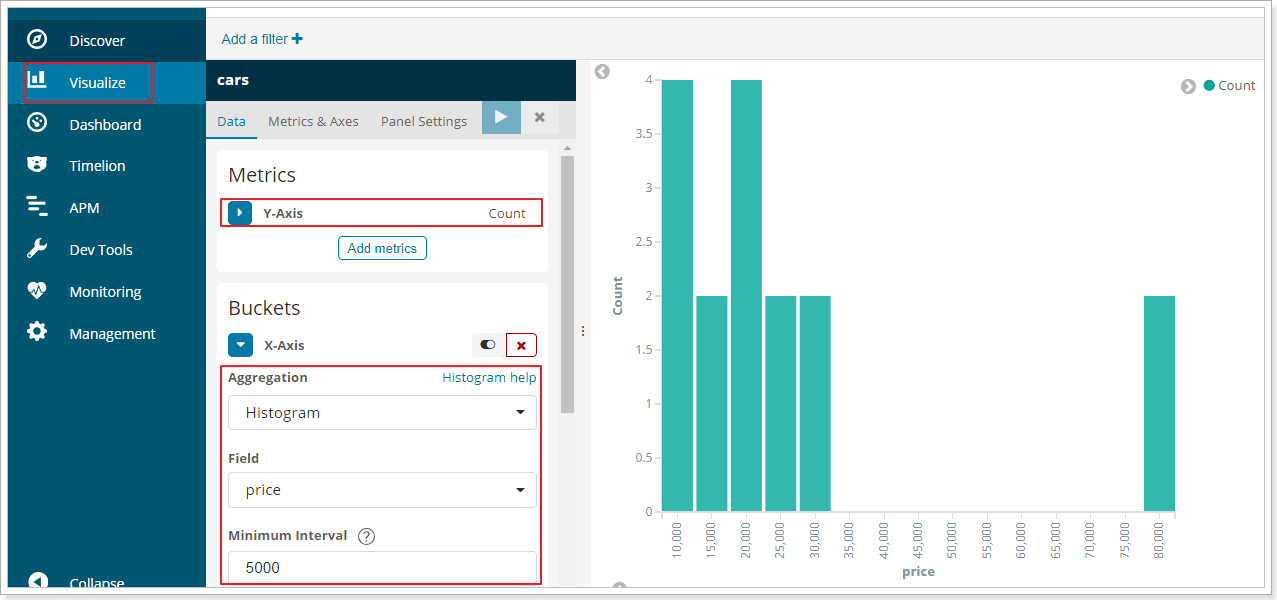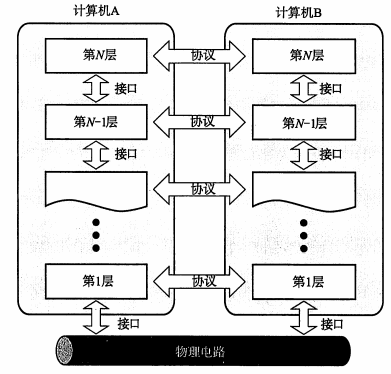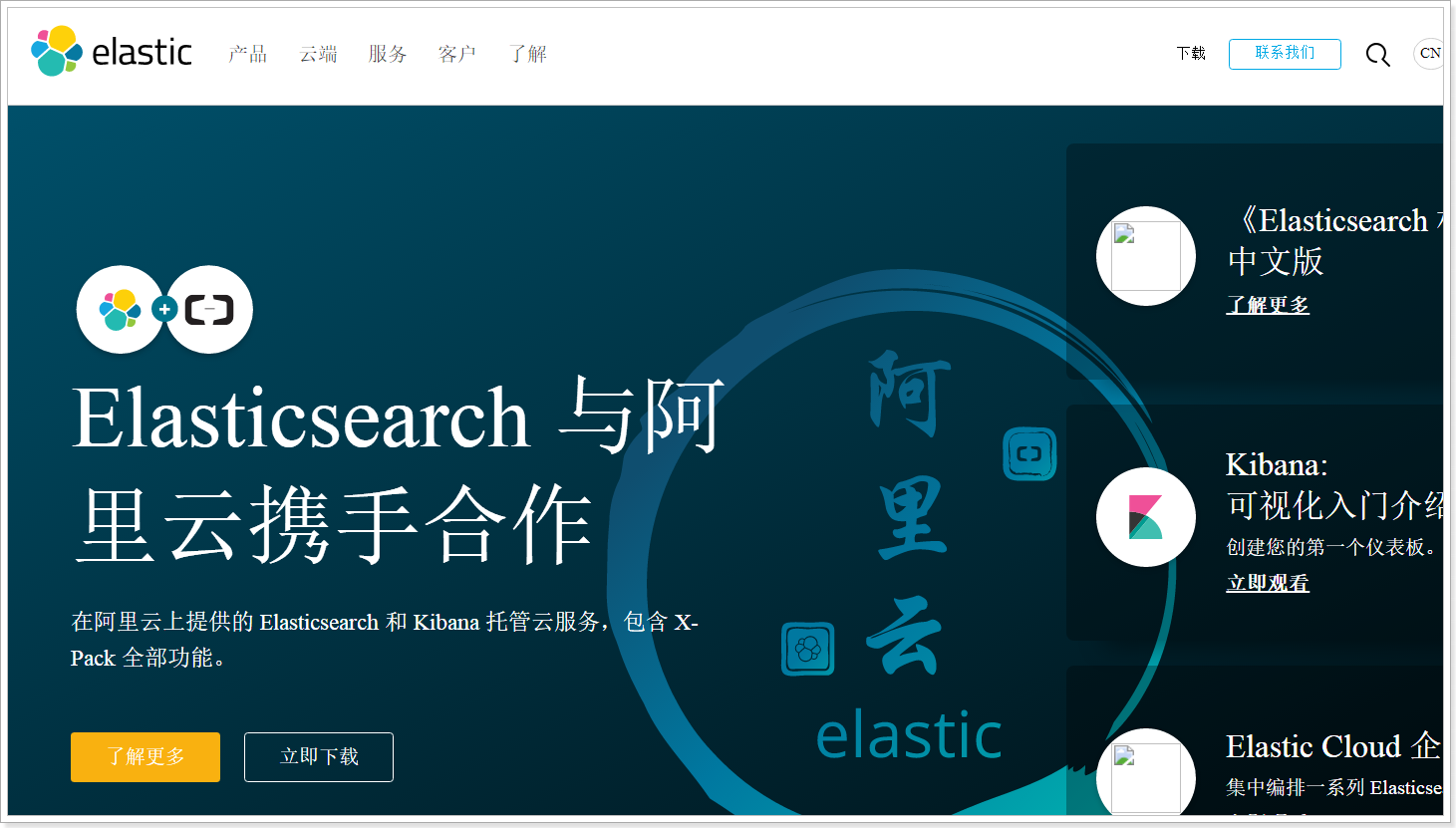Elasticsearch基本概念和使用
1.操作索引
1.1.基本概念
Elasticsearch也是基于Lucene的全文检索库,本质也是存储数据,很多概念与MySQL类似的。
对比关系:
索引(indices)——————————–Databases 数据库
类型(type)—————————–Table 数据表
文档(Document)—————-Row 行
字段(Field)——————-Columns 列
详细说明:
| 概念 | 说明 |
|---|---|
| 索引库(indices) | indices是index的复数,代表许多的索引, |
| 类型(type) | 类型是模拟mysql中的table概念,一个索引库下可以有不同类型的索引,比如商品索引,订单索引,其数据格式不同。不过这会导致索引库混乱,因此未来版本中会移除这个概念 |
| 文档(document) | 存入索引库原始的数据。比如每一条商品信息,就是一个文档 |
| 字段(field) | 文档中的属性 |
| 映射配置(mappings) | 字段的数据类型、属性、是否索引、是否存储等特性 |
是不是与Lucene和solr中的概念类似。
另外,在SolrCloud中,有一些集群相关的概念,在Elasticsearch也有类似的:
要注意的是:Elasticsearch本身就是分布式的,因此即便你只有一个节点,Elasticsearch默认也会对你的数据进行分片和副本操作,当你向集群添加新数据时,数据也会在新加入的节点中进行平衡。
1.2.创建索引
1.2.1.语法
Elasticsearch采用Rest风格API,因此其API就是一次http请求,你可以用任何工具发起http请求
创建索引的请求格式:
-
请求方式:PUT
-
请求路径:/索引库名
-
请求参数:json格式:
{ "settings": { "number_of_shards": 3, "number_of_replicas": 2 } }- settings:索引库的设置
- number_of_shards:分片数量
- number_of_replicas:副本数量
- settings:索引库的设置
1.2.2.测试
我们先用RestClient来试试
响应:
可以看到索引创建成功了。
1.2.3.使用kibana创建
kibana的控制台,可以对http请求进行简化,示例:
1.3.查看索引设置
语法
Get请求可以帮我们查看索引信息,格式:
GET /索引库名或者,我们可以使用*来查询所有索引库配置:
1.4.删除索引
删除索引使用DELETE请求
语法
DELETE /索引库名示例
再次查看heima2:
当然,我们也可以用HEAD请求,查看索引是否存在:
1.5.映射配置
索引有了,接下来肯定是添加数据。但是,在添加数据之前必须定义映射。
什么是映射?
映射是定义文档的过程,文档包含哪些字段,这些字段是否保存,是否索引,是否分词等
只有配置清楚,Elasticsearch才会帮我们进行索引库的创建(不一定)
1.5.1.创建映射字段
语法
请求方式依然是PUT
PUT /索引库名/_mapping/类型名称 { "properties": { "字段名": { "type": "类型", "index": true, "store": true, "analyzer": "分词器" } } }- 类型名称:就是前面将的type的概念,类似于数据库中的不同表
字段名:任意填写 ,可以指定许多属性,例如: - type:类型,可以是text、long、short、date、integer、object等
- index:是否索引,默认为true
- store:是否存储,默认为false
- analyzer:分词器,这里的
ik_max_word即使用ik分词器
示例
发起请求:
PUT heima/_mapping/goods { "properties": { "title": { "type": "text", "analyzer": "ik_max_word" }, "images": { "type": "keyword", "index": "false" }, "price": { "type": "float" } } } 响应结果:
{ "acknowledged": true } 1.5.2.查看映射关系
语法:
GET /索引库名/_mapping示例:
GET /heima/_mapping响应:
{ "heima": { "mappings": { "goods": { "properties": { "images": { "type": "keyword", "index": false }, "price": { "type": "float" }, "title": { "type": "text", "analyzer": "ik_max_word" } } } } } }1.5.3.字段属性详解
1.5.3.1.type
Elasticsearch中支持的数据类型非常丰富:
1.5.3.2.index
index影响字段的索引情况。
index的默认值就是true,也就是说你不进行任何配置,所有字段都会被索引。
但是有些字段是我们不希望被索引的,比如商品的图片信息,就需要手动设置index为false。
1.5.3.3.store
是否将数据进行额外存储。
在学习lucene和solr时,我们知道如果一个字段的store设置为false,那么在文档列表中就不会有这个字段的值,用户的搜索结果中不会显示出来。
但是在Elasticsearch中,即便store设置为false,也可以搜索到结果。
原因是Elasticsearch在创建文档索引时,会将文档中的原始数据备份,保存到一个叫做_source的属性中。而且我们可以通过过滤_source来选择哪些要显示,哪些不显示。
而如果设置store为true,就会在_source以外额外存储一份数据,多余,因此一般我们都会将store设置为false,事实上,store的默认值就是false。
1.5.3.4.boost
激励因子,这个与lucene中一样
其它的不再一一讲解,用的不多,大家参考官方文档:
1.6.新增数据
1.6.1.随机生成id
通过POST请求,可以向一个已经存在的索引库中添加数据。
语法:
POST /索引库名/类型名 { "key":"value" }示例:
POST /heima/goods/ { "title":"小米手机", "images":"http://image.leyou.com/12479122.jpg", "price":2699.00 }响应:
{ "_index": "heima", "_type": "goods", "_id": "r9c1KGMBIhaxtY5rlRKv", "_version": 1, "result": "created", "_shards": { "total": 3, "successful": 1, "failed": 0 }, "_seq_no": 0, "_primary_term": 2 }通过kibana查看数据:
get _search { "query":{ "match_all":{} } }{ "_index": "heima", "_type": "goods", "_id": "r9c1KGMBIhaxtY5rlRKv", "_version": 1, "_score": 1, "_source": { "title": "小米手机", "images": "http://image.leyou.com/12479122.jpg", "price": 2699 } }1.6.2.自定义id
如果我们想要自己新增的时候指定id,可以这么做:
POST /索引库名/类型/id值 { ... } 示例:
POST /heima/goods/2 { "title":"大米手机", "images":"http://image.leyou.com/12479122.jpg", "price":2899.00 }得到的数据:
{ "_index": "heima", "_type": "goods", "_id": "2", "_score": 1, "_source": { "title": "大米手机", "images": "http://image.leyou.com/12479122.jpg", "price": 2899 } }1.6.3.智能判断
在学习Solr时我们发现,我们在新增数据时,只能使用提前配置好映射属性的字段,否则就会报错。
不过在Elasticsearch中并没有这样的规定。
事实上Elasticsearch非常智能,你不需要给索引库设置任何mapping映射,它也可以根据你输入的数据来判断类型,动态添加数据映射。
测试一下:
POST /heima/goods/3 { "title":"超米手机", "images":"http://image.leyou.com/12479122.jpg", "price":2899.00, "stock": 200, "saleable":true }我们额外添加了stock库存,和saleable是否上架两个字段。
来看结果:
{ "_index": "heima", "_type": "goods", "_id": "3", "_version": 1, "_score": 1, "_source": { "title": "超米手机", "images": "http://image.leyou.com/12479122.jpg", "price": 2899, "stock": 200, "saleable": true } }在看下索引库的映射关系:
{ "heima": { "mappings": { "goods": { "properties": { "images": { "type": "keyword", "index": false }, "price": { "type": "float" }, "saleable": { "type": "boolean" }, "stock": { "type": "long" }, "title": { "type": "text", "analyzer": "ik_max_word" } } } } } }stock和saleable都被成功映射了。
如果存储的是String类型数据,ES无智能判断,他就会存入两个字段。例如:
存入一个name字段,智能形成两个字段:
- name:text类型
- name.keyword:keyword类型
1.7.修改数据
把刚才新增的请求方式改为PUT,就是修改了。不过修改必须指定id,
- id对应文档存在,则修改
- id对应文档不存在,则新增
比如,我们把id为3的数据进行修改:
PUT /heima/goods/3 { "title":"超大米手机", "images":"http://image.leyou.com/12479122.jpg", "price":3899.00, "stock": 100, "saleable":true }结果:
{ "took": 17, "timed_out": false, "_shards": { "total": 9, "successful": 9, "skipped": 0, "failed": 0 }, "hits": { "total": 1, "max_score": 1, "hits": [ { "_index": "heima", "_type": "goods", "_id": "3", "_score": 1, "_source": { "title": "超大米手机", "images": "http://image.leyou.com/12479122.jpg", "price": 3899, "stock": 100, "saleable": true } } ] } }1.8.删除数据
删除使用DELETE请求,同样,需要根据id进行删除:
语法
DELETE /索引库名/类型名/id值示例:
2.查询
我们从4块来讲查询:
- 基本查询
_source过滤- 结果过滤
- 高级查询
- 排序
2.1.基本查询:
基本语法
GET /索引库名/_search { "query":{ "查询类型":{ "查询条件":"查询条件值" } } }这里的query代表一个查询对象,里面可以有不同的查询属性
- 查询类型:
- 例如:
match_all,match,term,range等等
- 例如:
- 查询条件:查询条件会根据类型的不同,写法也有差异,后面详细讲解
2.1.1 查询所有(match_all)
示例:
GET /heima/_search { "query":{ "match_all": {} } }query:代表查询对象match_all:代表查询所有
结果:
{ "took": 2, "timed_out": false, "_shards": { "total": 3, "successful": 3, "skipped": 0, "failed": 0 }, "hits": { "total": 2, "max_score": 1, "hits": [ { "_index": "heima", "_type": "goods", "_id": "2", "_score": 1, "_source": { "title": "大米手机", "images": "http://image.leyou.com/12479122.jpg", "price": 2899 } }, { "_index": "heima", "_type": "goods", "_id": "r9c1KGMBIhaxtY5rlRKv", "_score": 1, "_source": { "title": "小米手机", "images": "http://image.leyou.com/12479122.jpg", "price": 2699 } } ] } }2.1.2 匹配查询(match)
我们先加入一条数据,便于测试:
PUT /heima/goods/3 { "title":"小米电视4A", "images":"http://image.leyou.com/12479122.jpg", "price":3899.00 }现在,索引库中有2部手机,1台电视:
- or关系
match类型查询,会把查询条件进行分词,然后进行查询,多个词条之间是or的关系
GET /heima/_search { "query":{ "match":{ "title":"小米电视" } } }结果:
"hits": { "total": 2, "max_score": 0.6931472, "hits": [ { "_index": "heima", "_type": "goods", "_id": "tmUBomQB_mwm6wH_EC1-", "_score": 0.6931472, "_source": { "title": "小米手机", "images": "http://image.leyou.com/12479122.jpg", "price": 2699 } }, { "_index": "heima", "_type": "goods", "_id": "3", "_score": 0.5753642, "_source": { "title": "小米电视4A", "images": "http://image.leyou.com/12479122.jpg", "price": 3899 } } ] }在上面的案例中,不仅会查询到电视,而且与小米相关的都会查询到,多个词之间是or的关系。
- and关系
某些情况下,我们需要更精确查找,我们希望这个关系变成and,可以这样做:
GET /heima/_search { "query":{ "match": { "title": { "query": "小米电视", "operator": "and" } } } }结果:
{ "took": 2, "timed_out": false, "_shards": { "total": 3, "successful": 3, "skipped": 0, "failed": 0 }, "hits": { "total": 1, "max_score": 0.5753642, "hits": [ { "_index": "heima", "_type": "goods", "_id": "3", "_score": 0.5753642, "_source": { "title": "小米电视4A", "images": "http://image.leyou.com/12479122.jpg", "price": 3899 } } ] } }本例中,只有同时包含小米和电视的词条才会被搜索到。
- or和and之间?
在 or 与 and 间二选一有点过于非黑即白。 如果用户给定的条件分词后有 5 个查询词项,想查找只包含其中 4 个词的文档,该如何处理?将 operator 操作符参数设置成 and 只会将此文档排除。
有时候这正是我们期望的,但在全文搜索的大多数应用场景下,我们既想包含那些可能相关的文档,同时又排除那些不太相关的。换句话说,我们想要处于中间某种结果。
match 查询支持 minimum_should_match 最小匹配参数, 这让我们可以指定必须匹配的词项数用来表示一个文档是否相关。我们可以将其设置为某个具体数字,更常用的做法是将其设置为一个百分数,因为我们无法控制用户搜索时输入的单词数量:
GET /heima/_search { "query":{ "match":{ "title":{ "query":"小米曲面电视", "minimum_should_match": "75%" } } } }本例中,搜索语句可以分为3个词,如果使用and关系,需要同时满足3个词才会被搜索到。这里我们采用最小品牌数:75%,那么也就是说只要匹配到总词条数量的75%即可,这里3*75% 约等于2。所以只要包含2个词条就算满足条件了。
结果:
2.1.3 多字段查询(multi_match)
multi_match与match类似,不同的是它可以在多个字段中查询
GET /heima/_search { "query":{ "multi_match": { "query": "小米", "fields": [ "title", "subTitle" ] } } }本例中,我们会在title字段和subtitle字段中查询小米这个词
2.1.4 词条匹配(term)
term 查询被用于精确值 匹配,这些精确值可能是数字、时间、布尔或者那些未分词的字符串
GET /heima/_search { "query":{ "term":{ "price":2699.00 } } }结果:
{ "took": 2, "timed_out": false, "_shards": { "total": 3, "successful": 3, "skipped": 0, "failed": 0 }, "hits": { "total": 1, "max_score": 1, "hits": [ { "_index": "heima", "_type": "goods", "_id": "r9c1KGMBIhaxtY5rlRKv", "_score": 1, "_source": { "title": "小米手机", "images": "http://image.leyou.com/12479122.jpg", "price": 2699 } } ] } }2.1.5 多词条精确匹配(terms)
terms 查询和 term 查询一样,但它允许你指定多值进行匹配。如果这个字段包含了指定值中的任何一个值,那么这个文档满足条件:
GET /heima/_search { "query":{ "terms":{ "price":[2699.00,2899.00,3899.00] } } }结果:
{ "took": 4, "timed_out": false, "_shards": { "total": 3, "successful": 3, "skipped": 0, "failed": 0 }, "hits": { "total": 3, "max_score": 1, "hits": [ { "_index": "heima", "_type": "goods", "_id": "2", "_score": 1, "_source": { "title": "大米手机", "images": "http://image.leyou.com/12479122.jpg", "price": 2899 } }, { "_index": "heima", "_type": "goods", "_id": "r9c1KGMBIhaxtY5rlRKv", "_score": 1, "_source": { "title": "小米手机", "images": "http://image.leyou.com/12479122.jpg", "price": 2699 } }, { "_index": "heima", "_type": "goods", "_id": "3", "_score": 1, "_source": { "title": "小米电视4A", "images": "http://image.leyou.com/12479122.jpg", "price": 3899 } } ] } }2.2.结果过滤
默认情况下,elasticsearch在搜索的结果中,会把文档中保存在_source的所有字段都返回。
如果我们只想获取其中的部分字段,我们可以添加_source的过滤
2.2.1.直接指定字段
示例:
GET /heima/_search { "_source": ["title","price"], "query": { "term": { "price": 2699 } } }返回的结果:
{ "took": 12, "timed_out": false, "_shards": { "total": 3, "successful": 3, "skipped": 0, "failed": 0 }, "hits": { "total": 1, "max_score": 1, "hits": [ { "_index": "heima", "_type": "goods", "_id": "r9c1KGMBIhaxtY5rlRKv", "_score": 1, "_source": { "price": 2699, "title": "小米手机" } } ] } }2.2.2.指定includes和excludes
我们也可以通过:
- includes:来指定想要显示的字段
- excludes:来指定不想要显示的字段
二者都是可选的。
示例:
GET /heima/_search { "_source": { "includes":["title","price"] }, "query": { "term": { "price": 2699 } } }与下面的结果将是一样的:
GET /heima/_search { "_source": { "excludes": ["images"] }, "query": { "term": { "price": 2699 } } }2.3 高级查询
2.3.1 布尔组合(bool)
bool把各种其它查询通过must(与)、must_not(非)、should(或)的方式进行组合
GET /heima/_search { "query":{ "bool":{ "must": { "match": { "title": "大米" }}, "must_not": { "match": { "title": "电视" }}, "should": { "match": { "title": "手机" }} } } }结果:
{ "took": 10, "timed_out": false, "_shards": { "total": 3, "successful": 3, "skipped": 0, "failed": 0 }, "hits": { "total": 1, "max_score": 0.5753642, "hits": [ { "_index": "heima", "_type": "goods", "_id": "2", "_score": 0.5753642, "_source": { "title": "大米手机", "images": "http://image.leyou.com/12479122.jpg", "price": 2899 } } ] } }2.3.2 范围查询(range)
range 查询找出那些落在指定区间内的数字或者时间
GET /heima/_search { "query":{ "range": { "price": { "gte": 1000.0, "lt": 2800.00 } } } }range查询允许以下字符:
| 操作符 | 说明 |
|---|---|
| gt | 大于 |
| gte | 大于等于 |
| lt | 小于 |
| lte | 小于等于 |
2.3.3 模糊查询(fuzzy)
我们新增一个商品:
POST /heima/goods/4 { "title":"apple手机", "images":"http://image.leyou.com/12479122.jpg", "price":6899.00 }fuzzy 查询是 term 查询的模糊等价。它允许用户搜索词条与实际词条的拼写出现偏差,但是偏差的编辑距离不得超过2:
GET /heima/_search { "query": { "fuzzy": { "title": "appla" } } }上面的查询,也能查询到apple手机
我们可以通过fuzziness来指定允许的编辑距离:
GET /heima/_search { "query": { "fuzzy": { "title": { "value":"appla", "fuzziness":1 } } } }2.4 过滤(filter)
条件查询中进行过滤
所有的查询都会影响到文档的评分及排名。如果我们需要在查询结果中进行过滤,并且不希望过滤条件影响评分,那么就不要把过滤条件作为查询条件来用。而是使用filter方式:
GET /heima/_search { "query":{ "bool":{ "must":{ "match": { "title": "小米手机" }}, "filter":{ "range":{"price":{"gt":2000.00,"lt":3800.00}} } } } }注意:filter中还可以再次进行bool组合条件过滤。
无查询条件,直接过滤
如果一次查询只有过滤,没有查询条件,不希望进行评分,我们可以使用constant_score取代只有 filter 语句的 bool 查询。在性能上是完全相同的,但对于提高查询简洁性和清晰度有很大帮助。
GET /heima/_search { "query":{ "constant_score": { "filter": { "range":{"price":{"gt":2000.00,"lt":3000.00}} } } }2.5 排序
2.5.1 单字段排序
sort 可以让我们按照不同的字段进行排序,并且通过order指定排序的方式
GET /heima/_search { "query": { "match": { "title": "小米手机" } }, "sort": [ { "price": { "order": "desc" } } ] }2.5.2 多字段排序
假定我们想要结合使用 price和 _score(得分) 进行查询,并且匹配的结果首先按照价格排序,然后按照相关性得分排序:
GET /goods/_search { "query":{ "bool":{ "must":{ "match": { "title": "小米手机" }}, "filter":{ "range":{"price":{"gt":200000,"lt":300000}} } } }, "sort": [ { "price": { "order": "desc" }}, { "_score": { "order": "desc" }} ] }3. 聚合aggregations
聚合可以让我们极其方便的实现对数据的统计、分析。例如:
- 什么品牌的手机最受欢迎?
- 这些手机的平均价格、最高价格、最低价格?
- 这些手机每月的销售情况如何?
实现这些统计功能的比数据库的sql要方便的多,而且查询速度非常快,可以实现实时搜索效果。
3.1 基本概念
Elasticsearch中的聚合,包含多种类型,最常用的两种,一个叫桶,一个叫度量:
桶(bucket)
桶的作用,是按照某种方式对数据进行分组,每一组数据在ES中称为一个桶,例如我们根据国籍对人划分,可以得到中国桶、英国桶,日本桶……或者我们按照年龄段对人进行划分:0~10,10~20,20~30,30~40等。
Elasticsearch中提供的划分桶的方式有很多:
- Date Histogram Aggregation:根据日期阶梯分组,例如给定阶梯为周,会自动每周分为一组
- Histogram Aggregation:根据数值阶梯分组,与日期类似
- Terms Aggregation:根据词条内容分组,词条内容完全匹配的为一组
- Range Aggregation:数值和日期的范围分组,指定开始和结束,然后按段分组
- ……
综上所述,我们发现bucket aggregations 只负责对数据进行分组,并不进行计算,因此往往bucket中往往会嵌套另一种聚合:metrics aggregations即度量
度量(metrics)
分组完成以后,我们一般会对组中的数据进行聚合运算,例如求平均值、最大、最小、求和等,这些在ES中称为度量
比较常用的一些度量聚合方式:
- Avg Aggregation:求平均值
- Max Aggregation:求最大值
- Min Aggregation:求最小值
- Percentiles Aggregation:求百分比
- Stats Aggregation:同时返回avg、max、min、sum、count等
- Sum Aggregation:求和
- Top hits Aggregation:求前几
- Value Count Aggregation:求总数
- ……
为了测试聚合,我们先批量导入一些数据
创建索引:
PUT /cars { "settings": { "number_of_shards": 1, "number_of_replicas": 0 }, "mappings": { "transactions": { "properties": { "color": { "type": "keyword" }, "make": { "type": "keyword" } } } } }注意:在ES中,需要进行聚合、排序、过滤的字段其处理方式比较特殊,因此不能被分词。这里我们将color和make这两个文字类型的字段设置为keyword类型,这个类型不会被分词,将来就可以参与聚合
导入数据
POST /cars/transactions/_bulk { "index": {}} { "price" : 10000, "color" : "red", "make" : "honda", "sold" : "2014-10-28" } { "index": {}} { "price" : 20000, "color" : "red", "make" : "honda", "sold" : "2014-11-05" } { "index": {}} { "price" : 30000, "color" : "green", "make" : "ford", "sold" : "2014-05-18" } { "index": {}} { "price" : 15000, "color" : "blue", "make" : "toyota", "sold" : "2014-07-02" } { "index": {}} { "price" : 12000, "color" : "green", "make" : "toyota", "sold" : "2014-08-19" } { "index": {}} { "price" : 20000, "color" : "red", "make" : "honda", "sold" : "2014-11-05" } { "index": {}} { "price" : 80000, "color" : "red", "make" : "bmw", "sold" : "2014-01-01" } { "index": {}} { "price" : 25000, "color" : "blue", "make" : "ford", "sold" : "2014-02-12" }3.2 聚合为桶
GET /cars/_search { "size" : 0, "aggs" : { "popular_colors" : { "terms" : { "field" : "color" } } } }- size: 查询条数,这里设置为0,因为我们不关心搜索到的数据,只关心聚合结果,提高效率
- aggs:声明这是一个聚合查询,是aggregations的缩写
- popular_colors:给这次聚合起一个名字,任意。
- terms:划分桶的方式,这里是根据词条划分
- field:划分桶的字段
- terms:划分桶的方式,这里是根据词条划分
- popular_colors:给这次聚合起一个名字,任意。
结果:
{ "took": 1, "timed_out": false, "_shards": { "total": 1, "successful": 1, "skipped": 0, "failed": 0 }, "hits": { "total": 8, "max_score": 0, "hits": [] }, "aggregations": { "popular_colors": { "doc_count_error_upper_bound": 0, "sum_other_doc_count": 0, "buckets": [ { "key": "red", "doc_count": 4 }, { "key": "blue", "doc_count": 2 }, { "key": "green", "doc_count": 2 } ] } } }- hits:查询结果为空,因为我们设置了size为0
- aggregations:聚合的结果
- popular_colors:我们定义的聚合名称
- buckets:查找到的桶,每个不同的color字段值都会形成一个桶
- key:这个桶对应的color字段的值
- doc_count:这个桶中的文档数量
通过聚合的结果我们发现,目前红色的小车比较畅销!
3.3 桶内度量
前面的例子告诉我们每个桶里面的文档数量,这很有用。 但通常,我们的应用需要提供更复杂的文档度量。 例如,每种颜色汽车的平均价格是多少?
因此,我们需要告诉Elasticsearch使用哪个字段,使用何种度量方式进行运算,这些信息要嵌套在桶内,度量的运算会基于桶内的文档进行
现在,我们为刚刚的聚合结果添加 求价格平均值的度量:
GET /cars/_search { "size" : 0, "aggs" : { "popular_colors" : { "terms" : { "field" : "color" }, "aggs":{ "avg_price": { "avg": { "field": "price" } } } } } }- aggs:我们在上一个aggs(popular_colors)中添加新的aggs。可见
度量也是一个聚合,度量是在桶内的聚合 - avg_price:聚合的名称
- avg:度量的类型,这里是求平均值
- field:度量运算的字段
结果:
... "aggregations": { "popular_colors": { "doc_count_error_upper_bound": 0, "sum_other_doc_count": 0, "buckets": [ { "key": "red", "doc_count": 4, "avg_price": { "value": 32500 } }, { "key": "blue", "doc_count": 2, "avg_price": { "value": 20000 } }, { "key": "green", "doc_count": 2, "avg_price": { "value": 21000 } } ] } } ...可以看到每个桶中都有自己的avg_price字段,这是度量聚合的结果
3.4 桶内嵌套桶
刚刚的案例中,我们在桶内嵌套度量运算。事实上桶不仅可以嵌套运算, 还可以再嵌套其它桶。也就是说在每个分组中,再分更多组。
比如:我们想统计每种颜色的汽车中,分别属于哪个制造商,按照make字段再进行分桶
GET /cars/_search { "size" : 0, "aggs" : { "popular_colors" : { "terms" : { "field" : "color" }, "aggs":{ "avg_price": { "avg": { "field": "price" } }, "maker":{ "terms":{ "field":"make" } } } } } }- 原来的color桶和avg计算我们不变
- maker:在嵌套的aggs下新添一个桶,叫做maker
- terms:桶的划分类型依然是词条
- filed:这里根据make字段进行划分
部分结果:
... {"aggregations": { "popular_colors": { "doc_count_error_upper_bound": 0, "sum_other_doc_count": 0, "buckets": [ { "key": "red", "doc_count": 4, "maker": { "doc_count_error_upper_bound": 0, "sum_other_doc_count": 0, "buckets": [ { "key": "honda", "doc_count": 3 }, { "key": "bmw", "doc_count": 1 } ] }, "avg_price": { "value": 32500 } }, { "key": "blue", "doc_count": 2, "maker": { "doc_count_error_upper_bound": 0, "sum_other_doc_count": 0, "buckets": [ { "key": "ford", "doc_count": 1 }, { "key": "toyota", "doc_count": 1 } ] }, "avg_price": { "value": 20000 } }, { "key": "green", "doc_count": 2, "maker": { "doc_count_error_upper_bound": 0, "sum_other_doc_count": 0, "buckets": [ { "key": "ford", "doc_count": 1 }, { "key": "toyota", "doc_count": 1 } ] }, "avg_price": { "value": 21000 } } ] } } } ...- 我们可以看到,新的聚合
maker被嵌套在原来每一个color的桶中。 - 每个颜色下面都根据
make字段进行了分组 - 我们能读取到的信息:
3.5.划分桶的其它方式
前面讲了,划分桶的方式有很多,例如:
- Date Histogram Aggregation:根据日期阶梯分组,例如给定阶梯为周,会自动每周分为一组
- Histogram Aggregation:根据数值阶梯分组,与日期类似
- Terms Aggregation:根据词条内容分组,词条内容完全匹配的为一组
- Range Aggregation:数值和日期的范围分组,指定开始和结束,然后按段分组
刚刚的案例中,我们采用的是Terms Aggregation,即根据词条划分桶。
接下来,我们再学习几个比较实用的:
3.5.1.阶梯分桶Histogram
原理:
histogram是把数值类型的字段,按照一定的阶梯大小进行分组。你需要指定一个阶梯值(interval)来划分阶梯大小。
举例:
比如你有价格字段,如果你设定interval的值为200,那么阶梯就会是这样的:
0,200,400,600,…
上面列出的是每个阶梯的key,也是区间的启点。
如果一件商品的价格是450,会落入哪个阶梯区间呢?计算公式如下:
bucket_key = Math.floor((value - offset) / interval) * interval + offsetvalue:就是当前数据的值,本例中是450
offset:起始偏移量,默认为0
interval:阶梯间隔,比如200
因此你得到的key = Math.floor((450 – 0) / 200) * 200 + 0 = 400
操作一下:
比如,我们对汽车的价格进行分组,指定间隔interval为5000:
GET /cars/_search { "size":0, "aggs":{ "price":{ "histogram": { "field": "price", "interval": 5000 } } } }结果:
{ "took": 21, "timed_out": false, "_shards": { "total": 5, "successful": 5, "skipped": 0, "failed": 0 }, "hits": { "total": 8, "max_score": 0, "hits": [] }, "aggregations": { "price": { "buckets": [ { "key": 10000, "doc_count": 2 }, { "key": 15000, "doc_count": 1 }, { "key": 20000, "doc_count": 2 }, { "key": 25000, "doc_count": 1 }, { "key": 30000, "doc_count": 1 }, { "key": 35000, "doc_count": 0 }, { "key": 40000, "doc_count": 0 }, { "key": 45000, "doc_count": 0 }, { "key": 50000, "doc_count": 0 }, { "key": 55000, "doc_count": 0 }, { "key": 60000, "doc_count": 0 }, { "key": 65000, "doc_count": 0 }, { "key": 70000, "doc_count": 0 }, { "key": 75000, "doc_count": 0 }, { "key": 80000, "doc_count": 1 } ] } } }你会发现,中间有大量的文档数量为0 的桶,看起来很丑。
我们可以增加一个参数min_doc_count为1,来约束最少文档数量为1,这样文档数量为0的桶会被过滤
示例:
GET /cars/_search { "size":0, "aggs":{ "price":{ "histogram": { "field": "price", "interval": 5000, "min_doc_count": 1 } } } }结果:
{ "took": 15, "timed_out": false, "_shards": { "total": 5, "successful": 5, "skipped": 0, "failed": 0 }, "hits": { "total": 8, "max_score": 0, "hits": [] }, "aggregations": { "price": { "buckets": [ { "key": 10000, "doc_count": 2 }, { "key": 15000, "doc_count": 1 }, { "key": 20000, "doc_count": 2 }, { "key": 25000, "doc_count": 1 }, { "key": 30000, "doc_count": 1 }, { "key": 80000, "doc_count": 1 } ] } } }完美,!
如果你用kibana将结果变为柱形图,会更好看:
3.5.2.范围分桶range
范围分桶与阶梯分桶类似,也是把数字按照阶段进行分组,只不过range方式需要你自己指定每一组的起始和结束大小。

